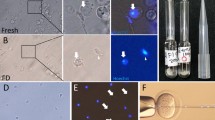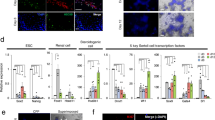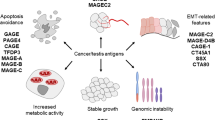Abstract
THE F9 antigen, defined by antisera raised in syngeneic mice against pluripotent embryonal carcinoma cells, is present on early mouse embryos, spermatozoa and male germinal cells, but not on adult somatic tissues1,2. This antigen, thought to be coded by gene(s) located at, or linked to, the developmentally important T/t complex, may play a part in early embryogenesis3–5. This idea is supported by the fact that the antigen seems to have been conserved during mammalian evolution. Anti-F9 activity is absorbed by sperm of several species including man, rat, rabbit and bull5–7 and there is evidence for its presence on the morulae of rabbit, rat and cow, and on human foetal testicular cells2,5. The cross reaction of anti-F9 with human sperm suggested that undifferentiated stem cells in human teratocarcinomas might also carry F9 on their surface, and we report here the isolation of human teratocarcinoma cell line which expresses F9 antigen.
This is a preview of subscription content, access via your institution
Access options
Subscribe to this journal
Receive 51 print issues and online access
$199.00 per year
only $3.90 per issue
Buy this article
- Purchase on Springer Link
- Instant access to full article PDF
Prices may be subject to local taxes which are calculated during checkout
Similar content being viewed by others
References
Artzt, K. et al. Proc. natn. Acad. Sci. U.S.A. 70, 2988–2992 (1973).
Gachelin, G., Fellous, M., Guenét, J-L. & Jacob, F. Devl Biol. 50, 310–320 (1976).
Atrzt, K., Bennett, D. & Jacob, F. Proc. natn. Acad. Sci. U.S.A. 71, 811–814 (1974).
Kemler, R. et al. Proc. natn. Acad. Sci. U.S.A. 73, 4080–4084 (1977).
Jacob, F. Immun. Rev. 33, 3–32 (1977).
Buc-Caron, M-H., Gachelin, G., Hofnung, M. & Jacob, F. Proc. natn. Acad. Sci. U.S.A. 71, 1730–1733 (1974).
Fellous, M., Gachelin, G., Buc-Caron, M-H., Dubois, P. & Jacob, F. Devl Biol. 41, 331–337 (1974).
Hogan, B. L. M. Nature 263, 136–137 (1976).
Clements, G., Klein, G., Zeulhen, J. & Povey, S. Somatic Cell Genet. 2, 309–324 (1976).
Janiaud, P., Le Calvez, J. & Aubert, Ch. Annly Derm. Syph. Paris 100, 536–539 (1973).
Willis, R. A. Pathology of Tumours, 3rd edn. (Butterworths, London, 1960).
Dixon, F. J. & Moore, R. A. Cancer 6, 427–454 (1953).
Mostafi, F. K. Rec. Results Cancer Res. 60, 176–195 (1977).
Holden, S. et al. Nature, 270, 518–520 (1977).
Author information
Authors and Affiliations
Rights and permissions
About this article
Cite this article
HOGAN, B., FELLOUS, M., JACOB, F. et al. Isolation of a human teratoma cell line which expresses F9 antigen. Nature 270, 515–518 (1977). https://doi.org/10.1038/270515a0
Received:
Accepted:
Issue Date:
DOI: https://doi.org/10.1038/270515a0
This article is cited by
-
The origins of human pluripotent stem cells: the road from a cancer to regenerative medicine
In Vitro Cellular & Developmental Biology - Animal (2024)
-
Role of MEK/ERK pathway in the MAD2-mediated cisplatin sensitivity in testicular germ cell tumour cells
British Journal of Cancer (2006)
-
From teratocarcinomas to embryonic stem cells and beyond: a history of embryonic stem cell research
Nature Reviews Genetics (2006)
Comments
By submitting a comment you agree to abide by our Terms and Community Guidelines. If you find something abusive or that does not comply with our terms or guidelines please flag it as inappropriate.



